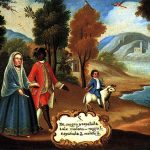 Colonial Latin America was a hotbed of diversity in ways that (for various reasons) colonial Africa, Asia, or even North America were not. And the Spanish state and its imperial bureaucracy were determined to chart and manage this complex demography, while social mores in the colonies themselves made much of even apparently small differences. There is no more vivid illustration of the desire to manage and negotiate difference than the so-called “casta paintings” that enjoyed a vogue in the colonial centres of eighteenth-century New Spain (that is, Mexico) and Peru.
Colonial Latin America was a hotbed of diversity in ways that (for various reasons) colonial Africa, Asia, or even North America were not. And the Spanish state and its imperial bureaucracy were determined to chart and manage this complex demography, while social mores in the colonies themselves made much of even apparently small differences. There is no more vivid illustration of the desire to manage and negotiate difference than the so-called “casta paintings” that enjoyed a vogue in the colonial centres of eighteenth-century New Spain (that is, Mexico) and Peru.
3. The Colonial Experience
There is no more vivid illustration of the desire to manage and negotiate difference than the so-called “casta paintings.”
There is also a podcast for this week and a video from Alec Dawson, as well as student-made videos.
- Catalina De Erauso, Lieutenant Nun (originally written and perhaps published around 1625-1630). Trans. Michele Stepto and Gabriel Stepto. Excerpt. The Appendix (April 3, 2013).
- Susan Deans-Smith, "Casta Paintings" (originally painted throughout the eighteenth century).
Colonialism
“The Colonial Experience”
Ana Gheorghiu and Lindsay Chapman on Catalina de Erauso and casta paintings:
Casta Paintings: An Introduction
Casta Paintings
Matilda Ahun, Craig Campbell, Sabeeha Manji, Isak Parker, and Roberto Pelayo Mazzone:
The Colonial Heritage
Alec Dawson (History and International Studies, SFU) considers the ways in which the colonial history of the region impacted the process of creating modern states in Latin America. Brought you with the help of Tupac Shakur and Jimmy Cliff.
The Colonial Heritage
Alec Dawson (Professor, History and International Studies, Simon Fraser University), author of Latin America Since Independence: A History with Primary Sources, considers the ways in which the colonial history of the region impacted the process of creating modern states in Latin America.
This podcast is designed to complement chapter one of his textbook.
- a full set of casta paintings, from seventeenth-century Mexico [link now disappeared?]
- Casta Paintings at Wikimedia Commons
- Peter Menzel, "Material World: Family Portraits"

- Claudio Nieto Rojas, "The City and the Spanish Colonial Project"

- Magali M. Carrera, Imagining Identity in New Spain: Race, Lineage, and the Colonial Body in Portraiture and Casta Paintings (Austin: University of Texas Press, 2004)
- Ilona Katzew, Casta Painting: Images of Race in Eighteenth-Century Mexico (New Haven: Yale University Press, 2004)
- Diana DiPaolo Loren, "Corporeal Concerns: Eighteenth-Century Casta Paintings and Colonial Bodies in Spanish Texas". Historical Archaeology 41.1 (2007): 23-36.
- Sherry Velasco, The Lieutenant Nun: Transgenderism, Lesbian Desire, and Catalina de Erauso (Austin: University of Texas Press, 2000)
- Consider the differences between settler colonialism and extractive colonialism. What are the implications of these differences? What kinds of patterns do they establish that might also explain differences between postcolonial societies?
- Check out some of the different casta paintings: lots are available online, and there are some links to some of them above, under "more resources." Look at the details. What is included and what is not? Why?
- Think about some of the differences between the various sets of paintings. Do they matter? Are some sets of paintings "better" than others, and if so, why?
- The paintings are of "types," rather than originals, and say little at first sight about individual psychology or personality. They speak rather through the figures' attributes. But we do often judge or classify people by their clothing, possessions, homes, and so on. (Compare perhaps Peter Menzel's "Material World: Family Portraits".) What can we tell about people from the things that surround them?
- In what ways was Catalina de Erauso a rebel? And in what ways did she perhaps perpetuate some of the hierarchies of the colonial world?
- It's tempting to see the past in terms of the present. In fact, it's probably inevitable that we do so, to some extent at least. What is gained or lost if we paint Catalina de Erauso as (say) a gender-defying queer or lesbian feminist ahead of her time?
- Thinking back to the hierarchies depicted in the casta paintings... It's unusual that we hear the voices of those who are at the bottom of such hierarchies: the poor, indigenous, black, or women even when they were white and elite. What do we miss as a result? How might that affect the ways in which we read the historical texts that we do have?





